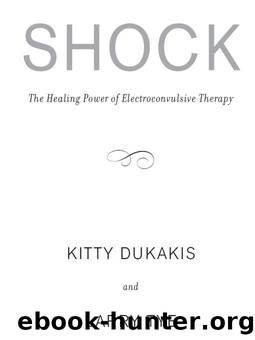Shock by Dukakis Kitty & Larry Tye

Author:Dukakis, Kitty & Larry Tye
Language: eng
Format: epub
Publisher: PENGUIN group
Published: 2010-02-25T16:00:00+00:00
Nearly seventy years after its launch, researchers also know more about where ECT has a less dramatic effect or none at all.
Schizophrenia is one such condition. It was ECT’s first target and remained one of its most popular through the 1940s and 1950s, a time when the frightening diagnosis was applied to almost everyone in the asylum, including many whose actual disease was depression, mania, manic depression, or drug addiction. Thorazine and other antipsychotic drugs started to displace ECT for treating schizophrenics in the 1950s, and the defection picked up steam through the 1960s and 1970s. By the time doctors and patients began to sense the limits and complications of the miracle drugs in the 1980s and afterward, the world of schizophrenia had changed in a way that was unfriendly to ECT. The treatment was no longer offered in many state mental hospitals that housed schizophrenic patients; others with the illness were no longer institutionalized, and some of them no longer had access to electroshock or any other treatment. An even bigger transformation was that ECT had gone from being a first-choice treatment for schizophrenia to a backup, with patients referred today only after antipsychotic and neuroleptic medications have failed. The upshot is that while in 1980 schizophrenia accounted for 16.5 percent of in-hospital ECT usage, by 1986 that number had tumbled to 6.5 percent, and today it almost certainly has slipped further.
Scientists also have been taking a hard look at the use of ECT with schizophrenia and have rendered a judgment kinder than the practitioners. While reports from ECT’s earliest days of a 75 percent response rate have not held up with schizophrenia the way they did with depression, more rigorous reviews demonstrate that it can help schizophrenic patients with symptoms known to respond to electroshock, including depression, catatonia, paranoia, and overexcitement. Even when those syndromes are not present ECT can help, just not as often or by as much. One way to raise the odds is to start treatment as close as possible to the onset of the disease generally and the current episode especially. Another is to combine ECT with antischizophrenia drugs like chlozapine. Convulsive therapy is less likely to work with patients who have unwavering, persistent schizophrenia. Yet even there, since drugs seldom work, many psychiatrists say it is worth trying ECT.
Valerie did try. The Kentuckian has a condition called schizoaffective disorder, which combines symptoms of schizophrenia and bipolar disorder. She started getting ECT in 1999, having failed to find relief from a litany of antipsychotic medicines. “The hallucinations went away eight to ten weeks after the ECT, and oh, yes, that was the reason,” says the thirty-four-year-old, who asks that her last name not be used. “It was just phenomenal to have ten weeks of silence.” The voices eventually came back, but her medications keep them down to what she describes as volume four on a scale of one to ten. “There’s a possibility,” Valerie adds, “that it was the ECT that made my meds more effective.
Download
This site does not store any files on its server. We only index and link to content provided by other sites. Please contact the content providers to delete copyright contents if any and email us, we'll remove relevant links or contents immediately.
Should I Stay or Should I Go? by Ramani Durvasula(6785)
Why We Sleep: Unlocking the Power of Sleep and Dreams by Matthew Walker(5642)
Fear by Osho(4085)
Flow by Mihaly Csikszentmihalyi(4053)
Rising Strong by Brene Brown(3781)
Why We Sleep by Matthew Walker(3773)
Too Much and Not the Mood by Durga Chew-Bose(3695)
How to Change Your Mind by Michael Pollan(3679)
The Hacking of the American Mind by Robert H. Lustig(3580)
Lost Connections by Johann Hari(3455)
He's Just Not That Into You by Greg Behrendt & Liz Tuccillo(3303)
Evolve Your Brain by Joe Dispenza(3051)
What If This Were Enough? by Heather Havrilesky(2945)
Resisting Happiness by Matthew Kelly(2887)
Crazy Is My Superpower by A.J. Mendez Brooks(2861)
The Courage to Be Disliked by Ichiro Kishimi & Fumitake Koga(2797)
The Book of Human Emotions by Tiffany Watt Smith(2771)
Descartes' Error by Antonio Damasio(2731)
In Cold Blood by Truman Capote(2685)
